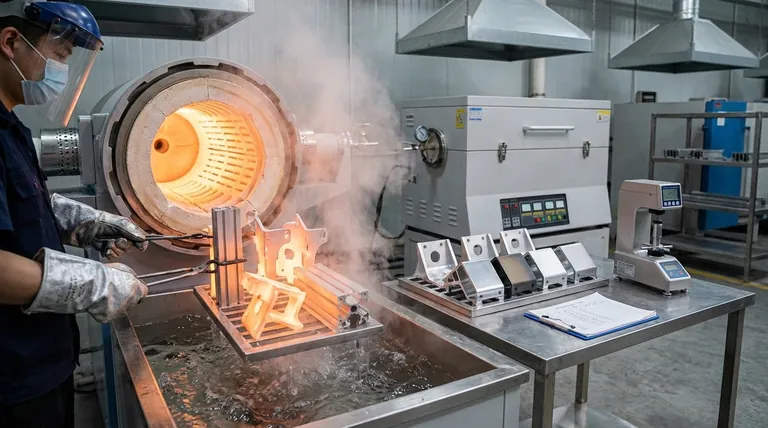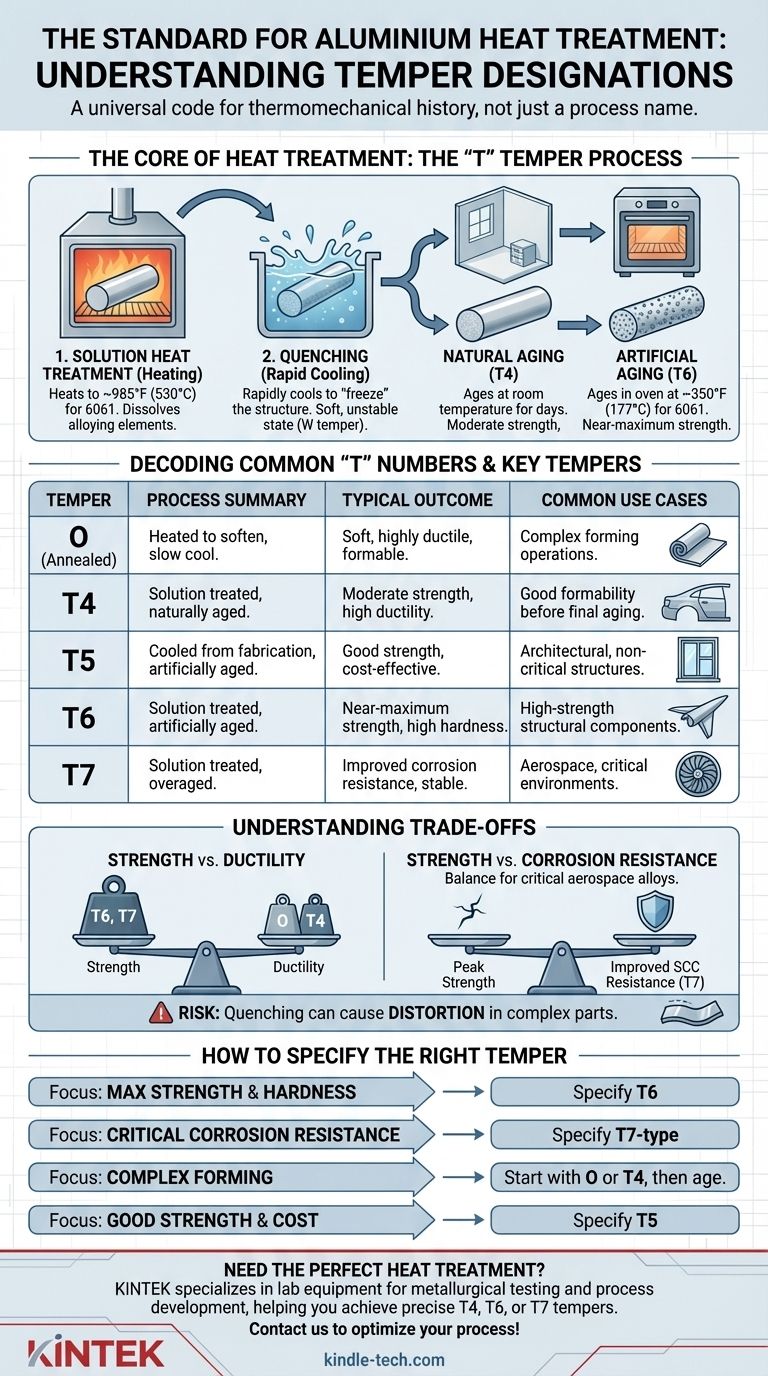簡単な答えは、アルミニウム熱処理に関する「標準」と呼ばれる単一の文書は存在しないということです。その代わりに、業界では調質記号(temper designations)として知られる標準化されたコーディングシステムを使用して、アルミニウム合金が受けた熱的および機械的プロセスの正確なシーケンスを定義しています。このシステムはアルミニウム協会によって管理されており、文字の後に1つ以上の数字(例:6061-T6)を付けて、材料の最終的な機械的特性を伝えます。
アルミニウムの調質記号システムを理解することが、熱処理を指定するための鍵となります。このコードは単にプロセスを指し示すだけでなく、材料の熱機械的履歴全体、ひいてはその最終的な強度、硬度、延性を記述しています。

基礎:調質記号システム
調質記号は、6061-T6の「T6」のように、合金番号に付加される接尾辞です。この単純なコードは、エンジニア、冶金学者、機械工にとっての共通言語です。
基本的な記号
調質記号には、文字で示される5つの主要なファミリーがあります。そのうち、「T」シリーズのみが、硬化を達成するために熱処理を伴います。
- F - As Fabricated(加工のまま): 熱処理または加工硬化条件について特別な管理が行われていない製品に適用されます。保証された機械的特性はありません。
- O - Annealed(焼なまし): 最も柔らかく、最も延性に富んだ調質です。合金を加熱して結晶構造を再形成させ、応力を除去し、加工性を最大化することで達成されます。
- H - Strain-Hardened(加工硬化): これは熱処理されない合金(3xxx系や5xxx系など)にのみ適用されます。金属を低温で物理的に加工する(例:圧延や引抜き)ことによって強度が増加します。
- W - Solution Heat-Treated(時効処理前): これはまれで不安定な調質です。固溶化処理と急冷の直後の状態を示し、その後の時効処理が行われる前です。通常、内部プロセスの制御のためだけに指定されます。
「T」記号を解読する:熱処理の核心
「T調質」は、熱処理されたアルミニウムについて言及するときに、ほとんどの人が意味するものです。これは熱処理可能な合金(2xxx系、6xxx系、7xxx系など)に適用され、材料が特定の熱処理プロセスによって強化されたことを示します。
「T」調質のための3段階プロセス
安定した「T」調質を達成するには、析出硬化と呼ばれる正確な3段階のプロセスが必要です。
- 固溶化処理(加熱): アルミニウムを特定の高温(例:6061の場合は約985°F / 530°C)に加熱し、保持します。これにより、主要な合金元素(マグネシウムやケイ素など)が固溶体中に溶解します。これは、熱湯に砂糖を溶かすのに似ています。
- 急冷(急速冷却): その後、材料を水などで急速に冷却します。これにより、合金元素がその場に「凍結」され、過飽和固溶体が形成されます。この時点で材料は柔らかく不安定な状態(「W」調質)になります。
- 時効処理(析出硬化): 材料を一定時間、室温または低温オーブンで保持します。この段階で、溶解した合金元素が極めて微細で分散した粒子として溶液から析出し、転位の移動を妨げ、合金の強度と硬度を劇的に向上させます。
自然時効と人工時効
最終的な特性は、時効ステップがどのように実行されるかによって決まります。
- 自然時効(T4): 急冷後、部品を室温で数日間放置して時効させます。これにより、中程度の強度と高い延性を持つ調質が得られます。
- 人工時効(T6): 急冷後、部品を低温(例:6061の場合は約350°F / 177°C)のオーブンに数時間入れます。これにより析出が促進され制御され、ほぼ最大の強度と硬度が得られます。
一般的な「T」番号の解読
「T」の後に続く数字は、特定のプロセスに関する詳細情報を提供します。
- T4: 固溶化処理後、実質的に安定した状態になるまで自然時効処理したもの。
- T5: 押出成形などの高温製造プロセスから冷却した後、人工時効処理したもの。これは強度が得られる低コストの選択肢ですが、T6ほど強くはありません。
- T6: 固溶化処理後、人工時効処理したもの。多くの合金で最も一般的な高強度調質です。
- T7: 固溶化処理後、過時効処理(ピーク強度を超えて人工時効処理したもの)。これは、寸法安定性と応力腐食割れに対する耐性を向上させるために意図的に行われます。
トレードオフの理解
調質記号の選択は、競合する特性のバランスを取るエンジニアリング上の決定です。単に「最も強い」オプションを選ぶことではありません。
強度 対 延性
主なトレードオフは、強度と延性の間です。O調質(焼なまし)部品は柔らかく成形しやすいですが、弱いです。T6調質部品は非常に強いですが、脆く、容易に成形できません。
強度 対 耐食性
特定の合金、特に航空宇宙で使用される7xxx系合金では、ピーク強度と引き換えに応力腐食割れ(SCC)に対する感受性が高くなります。T7タイプの調質は、強度を意図的に犠牲にしてSCC耐性を大幅に向上させるため、重要なコンポーネントにとってより安全な選択肢となります。
歪みのリスク
急冷ステップ中の急速な冷却は熱衝撃であり、大きな内部応力を誘発します。これにより、薄い部品や複雑な部品が反ることがよくあります。この歪みは、矯正または後続の応力除去操作によって修正する必要がある場合があります。
適切な調質の指定方法
調質の選択は、部品の機能、製造プロセス、および使用環境によって決定される必要があります。
- 最大の強度と硬度が主な焦点の場合: ほとんどの一般的な合金で実用的な最高強度を発現するため、T6調質を指定します。
- 重要な環境での耐食性が主な焦点の場合: 強度のわずかな低下を受け入れ、安定性と応力腐食割れに対する耐性を得るために、T7タイプの調質(例:T73、T76)を指定します。
- 複雑な形状の成形が主な焦点の場合: 材料をO調質またはT4調質で開始し、成形操作を実行した後、最終的な時効プロセスを実行します。
- 良好な強度と低コストのバランスが主な焦点の場合: T6の極端な性能が要求されない建築用途や非重要構造用途では、T5調質で十分な場合が多くあります。
結局のところ、アルミニウム熱処理を習得することは、この標準的な指定システムを使用して、材料の特性をアプリケーションの要求に正確に一致させることです。
要約表:
| 調質記号 | 主要プロセス | 典型的な結果 | 一般的な使用例 |
|---|---|---|---|
| O(焼なまし) | 軟化のための加熱 | 柔らかい、高い延性 | 複雑な成形操作 |
| T4 | 固溶化処理後、自然時効 | 中程度の強度、高い延性 | 最終時効前の良好な成形性 |
| T5 | 製造工程からの冷却後、人工時効 | 良好な強度、コスト効率 | 建築、非重要構造物 |
| T6 | 固溶化処理後、人工時効 | ほぼ最大の強度、高い硬度 | 高強度構造部品 |
| T7 | 固溶化処理後、過時効 | 耐食性の向上、安定 | 航空宇宙、重要環境 |
プロジェクトに最適なアルミニウム熱処理を指定する必要がありますか?
KINTEKは、冶金試験およびプロセス開発のためのラボ機器と消耗品を専門としています。当社の専門家は、正確なT4、T6、またはT7調質を達成するために適切な炉とツールを選択するお手伝いをし、アルミニウム部品が要求される強度、延性、耐食性の要件を満たすことを保証します。
今すぐ当社のチームに連絡して、アプリケーションについて話し合い、熱処理プロセスを最適化してください!
ビジュアルガイド

関連製品
- 1700℃実験室用石英管炉 アルミナチューブ付き管状炉
- 垂直管式石英管炉
- 2200℃ タングステン真空熱処理・焼結炉
- 黒鉛真空炉 高熱伝導率フィルム黒鉛化炉
- セラミックファイバーライニング付き真空熱処理炉



















